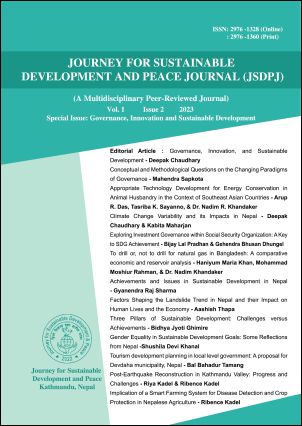Factors Shaping the Landslide Trend in Nepal and their Impact on Human Lives and the Economy
DOI:
https://doi.org/10.3126/jsdpj.v1i02.58265Keywords:
Climatic, Landslide, Geography, Antropogenic, Sustainable, EconomyAbstract
This paper explores the status of landslide occurrence in Nepal, attributing it to a combination of factors such as geographical features, seismic activity, climate conditions, and anthropogenic factors like unregulated road construction. The landslides pose a serious threat to human lives and economic stability, particularly in high-risk areas like the mid-hills and mountain regions of Nepal. Seasonal variations in landslides have been influenced by monsoon activity, while poorly planned and constructed roads exacerbate the issue. The paper aims to highlight the vulnerability of Nepal's geography to landslides through case studies and existing literature. It concludes that landslides result from a complex interplay of geographical, climatic, and anthropogenic elements. To address the situation, the focus should be on sustainable infrastructure development, especially in mid-hills and mountain regions, by considering proper grading and drainage patterns during road construction. This approach can effectively mitigate anthropogenic factors and bring economic benefits to the nation while promoting a safer and more resilient future.
Downloads
Downloads
Published
How to Cite
Issue
Section
License
This license enables reusers to distribute, remix, adapt, and build upon the material in any medium or format for noncommercial purposes only, and only so long as attribution is given to the creator.




